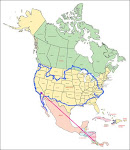
George's mom, lovingly called Grana, is quite the adventure traveler. She travels the world with her sister, and they have visited such amazing places as China, Africa, New Zealand, Egypt; and now she can add Costa Rica to her list. She visited us for a week, and once again I marveled at how adventurous her spirit is. She wanted to go on an adventure with us while she was here, and we were happy to oblige. We wanted to visit Corcovado National Park, so we booked a stay at one of the Corcovado Ranger Stations, the Sirena Station, in the heart of the park.
Our adventure started with a taxi ride at dawn to the town of Sierpe, and to a restaurant / tour outfit called Las Vegas, where we boarded our boat.

We took a 2 1/2 hour boat ride which started out on the Sierpe River, through Costa Rica's largest mangrove forest.


About 45 minutes into our boat ride, we came to the mouth of the river and ventured out into the ocean. For the rest of our journey to Sirena Station, we rode along the beautiful, rugged, rocky, jungley coast, and Grana and I were singing our praises to our sea-sickness medication!



We were dropped of in the waves near the beach, thrilled to be on terra firma once again.

After unloading the boat and putting our shoes on, we were ready to explore the park.


In the 24 hours that we were in Corcovado National Park, we saw an unbelievable amount of wildlife. There was something climbing or flying through the canopy, or strolling through the forest floor nearly everywhere we looked. We wouldn't have seen nearly as much as we did, however, without our amazing guide. His name is Fernando, but he told us to call him "Gato", meaning Cat. And just like a cat, he spotted animals when other guides passed them by. He also knew everything we could have wanted to know about any of the animals we saw.

Grana made a list of all the animals we saw on our multiple walks with Gato, and in 2 days she had written down over 30 different types of animals, including:
Peccaries (We saw both species, the white-lipped and the collared peccaries.) Here's a group white-lipped peccaries, supposedly the most aggressive mammal in Costa Rica, but these barely seemed to notice our existence.

Grana got to see all 4 species of monkeys! You'll have to look in a previous post to see the howler monkeys, but here's photos of the other 3 kinds:
Spider monkeys have the strongest prehensile tails of any monkey, but have lost their thumbs throughout evolution.

White-Faced Capuchin Monkeys are exceedingly smart and use tools like sticks to eat termites, and have also been known to tie 2 ears of corn together by their husks and wrap them around their necks so they can carry more when raiding a farmer's corn patch.

We also saw the Squirrel Monkeys, who are by far the smallest and cutest of them all. We even got to see a baby squirrel monkey - too cute!

We also had the rare opportunity to see a Tapir, the largest land mammal in Costa Rica. It's the size of a small cow, and we caught a glimpse of it while it was napping.

We also saw many 3-toed Tapir tracks in the mud, like this one.

Bull sharks also inhabit the waters in and around Corcovado. Bull sharks are able to tolerate both fresh water and salt water, and we saw several of them surfing in the waves at the mouth of the river. Here we are watching for them.

And here is the fin of one Bull Shark.

We spent the night at the Sirena Ranger Station Dormitory, a pleasant (but very basic) hostel-style complex, where you have to hike in from the beach landing. If you ever decide to come here, which I highly recommend, be sure to bring your own sheet and pillow. Luckily, we asked about these things before we came, but we failed to ask about bringing toilet paper, and evidently this is a BYOTP kind of place.

Luckily, Gato rounded some up for us. Like Grana said, "Bless his heart-strings!"

The food here was very good and we enjoyed learning more about our guide while we shared meals.

We awoke early the next morning for a sunrise / moonset walk, in hopes to see the tapirs come to the river to bathe. Unfortunately, we did not see any more tapirs, but we did enjoy a beautiful morning on the beach and the banks of the river.


We also found a turtle-egg lying on the beach.

We also saw many beautiful and fascinating plants while in Corcovado, like these 2 kinds of passion flowers:


And the jungle is full of amazing trees.

Here's a huge wild cashew tree that supports a whole host of other plants.

Another neat view into the canopy.

And of course, there were strangler figs.

We even found this bees' nest in the base of one tree. The bees had formed an interesting propolis entrance into their hive.

Even after we left Corcovado, as we made our way back through the mangroves, we continued to see a lot of wildlife, including this boa constrictor

and this neat "tiger-faced" crab.

Gato also spotted 3 Scarlet Macaws in a tree, thus completing Grana's wishlist of animals to see.

During our car ride home, we stopped by a public park in the town of Palmar Norte to admire these
bolas, perfectly carved granite spheres which were made by the natives of this area thousands of years ago. No one knows how they made them, or how they used them. I love mysterious things like these!



Grana, you are quite a trooper, and we had a wonderful visit with you!





































































